Mike Saulters's blog
SXSW on $8/Day: Advice for Film Pass Attendees
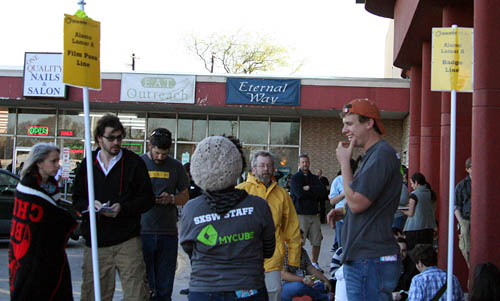
In 1969, my mother and her best friend waited in line for Butch Cassidy and the Sundance Kid five times without ever getting in to see it. Her parents, unbelieving, went to the four-plex, and also were turned away twice due to sold-out shows before getting in. Such was the power of Newman and Redford in the days before internet ticket services like Fandango. Carrying a film pass at SXSW this year feels almost like a return to that era.
Film passes are an economical way to enjoy the fest if you plan to take in six or more films and don't have the funds or time to volunteer in order to get a badge. Entry to films goes first to badgeholders, then to those with a film pass, and finally to people who are buying individual tickets.
Here are a few tips on what to expect (and how to survive) when using the SXSW Film equivalent of the music wristbands.
- Expect the unexpected. I arrived early and spent three hours at the front of the line for Hesher this weekend at Alamo Drafthouse on South Lamar, failing to gain a seat when there wasn't enough room for some 30-50 badgeholders ahead of me. The passes ARE printed with a warning to avoid screenings at the Alamo Drafthouse locations due to their smaller size. However, I felt confident most people would be downtown catching the world premiere of Paul at the Paramount. Boy, was I wrong, as people had a tendency to pick a venue and stay there for the day. They'd walk out of the Drafthouse and right into line for the next screening, which happened to be mine. I understand there was room to spare at the Paul premiere.
Ain't It Cool News Celebrates its 15th Anniversary at SXSW
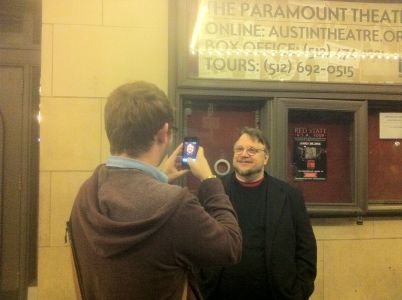
An estimated 800-900 people gathered last night to celebrate the 15th anniversary of Ain't It Cool News (AICN) with a special secret screening at the crown jewel of Austin theater, the Paramount.
In the 15 years since Harry Knowles started the site from his hospital bed after hurting his back, AICN has shaken the very foundations of Hollywood. It has brought to their knees studios that have produced unworthy pictures as well as lauding countless works that might otherwise have gone unsung. AICN has cultivated and sculpted the face of Austin movie culture, benefitting from and cross-promoting with Alamo Drafthouse Cinemas as both have grown to become household names. In 2005, AICN announced the founding of the greatest genre film festival in existence, Fantastic Fest which brings together fans, filmmakers, and big names from around the world for the seventh year this September. If the Alamo Drafthouse is the heart of the Austin film community, AICN is its soul.
SXSW Interview: Djo Tunda Wa Munga, 'Viva Riva!'
 I was fortunate to have a few minutes with Djo Tunda Wa Munga, the writer/director of Viva Riva!, to discuss the movie after I saw it at SXSW on Friday night. Read my review first, to get an idea of what Viva Riva! is about and why I enjoyed it so much.
I was fortunate to have a few minutes with Djo Tunda Wa Munga, the writer/director of Viva Riva!, to discuss the movie after I saw it at SXSW on Friday night. Read my review first, to get an idea of what Viva Riva! is about and why I enjoyed it so much.
MS: Would you consider this something of a blaxploitation film?
Djo: I actually have to be honest with you, because people ask me that question thinking that maybe I did it in that sense. Not really, OK, and because that was not the source of inspiration, even if I like blaxploitation, but I didn't think about it when I was developing the movie. But what I can see is probably in terms of, like expression, in violence and the social tensions that we had were maybe similar to what you had in the 70s and 60s in the black community, that there is a parallel.
MS: I loved everything, I loved that it was very gritty, very visceral. There were some people in the audience who were shocked at the violence, and I'm coming from a background of Quentin Tarantino films, etc. Were you surprised to get that reception, do you think maybe that this was the wrong audience?
Djo: I'm really surprised that people say the film is so violent, because you expect that, I mean, the idea we have of American movies are quite violent. Maybe that has changed these last years, but I am surprised by that reaction. But, maybe the audience should be younger and maybe that's like maybe that's their fear, they would relate to it more easily.
MS: Have you come to the fest trying to sell the film?
Djo: No, I came to the fest first trying to meet the American audience. That was the first work because the film is being released in the U.S., which means we sold it already. It's being released the 10th of June, by Music Box.
SXSW Review: Viva Riva!

A few facts about the Democratic Republic of the Congo, which you may have known as Zaire: It is the third largest country in Africa and the 12th largest in the world, and the 18th most populous. The citizens are some of the poorest in the world, but the country has untapped natural resources estimated at $24 trillion, making it the richest country in the world. It has been for the last 40 years one of the most corrupt, violent, and lawless places on the planet.
Djo Tunda Wa Munga (pronounced "Joe" for short) has written, produced, and directed the first movie ever to come out of the Congo, a country which until now has had no film industry. Viva Riva! is a gorgeously gritty, sexy adventure that, if it were a book, you couldn't put down. An unintentional blaxploitation piece, the core is a plot you might see in a Tarantino film or something like Snatch, but with all the dials turned up to 11. The depth of violence here isn't an attempt to pander to adolescent bloodlust, but rather an expression of the severe circumstances in which people have had to live in that country.
Review: Battle: Los Angeles
When I was a young man in junior high, 25 years ago, I read a passage about a group of young men, cadets at the U.S. Air Force Academy who were the last desperate stand of resistance against an unstoppable alien invasion. The author created such an image of heroism that for the next five years it was my entire goal to one day be a cadet at the Air Force Academy.
It took the first Iraq war to scare me away from that path. The author of that piece was L. Ron Hubbard, and the book was Battlefield: Earth, which was eventually adapted into one of the worst films ever made, a film that flushed John Travolta's career so far down the toilet only Quentin Tarantino could reach down and pull him out. Battle: Los Angeles may be for this generation what that book was for me. It plays exactly like a two-hour commercial for the US Marines.
Aaron Eckhart is the sergeant, haunted by the loss of his last platoon, ready to retire, forced by an alien invasion to take a batch of new recruits just out of training into the heart of combat on a mission to find and retrieve any civilians in the area before the bombs are dropped to stop the invaders.
SXSW Review: The First Movie

My favorite thing about a film fest like SXSW is the possibility it allows to step outside your normal comfort levels and discover something you really love that you never expected, or at least something incredibly noteworthy and interesting. The international aspect opens a path not just to films but to nations and cultures that get little or no media coverage in the US. My first film selection for 2011, aptly titled The First Movie, is a documentary that ventures into the most remote section of Iraqi Kurdistan, a region decimated by war.
The First Movie is a sort of dreamy documentary exploration into the filmmaker's psyche. Mark Cousins narrates his journey to Goptapa in northern Iraq, a farming village that in 1988 fell victim to chemical warfare attacks by Saddam Hussein's forces, instantly killing one in seven people. Cousins describes growing up in northern Ireland and how the beauty of the country, unmarked by the violence, seems more real than the war that tore through it.
Review: Rango
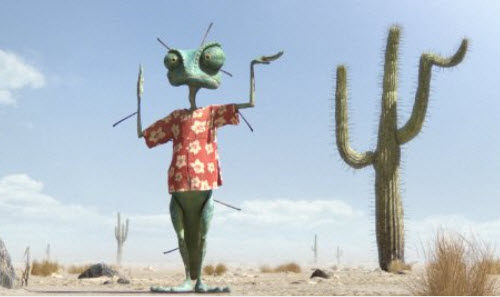
It was disappointing to hear that director Gore Verbinski wouldn't be making the next Pirates of the Caribbean movie, but now that I've seen the reason, all is forgiven. Rango, opening today, is a family movie that isn't just for kids, and not only for kids and their parents, either. Rated PG, the animated film includes saucy, bawdy, even raunchy language that will give parents a good belly-laugh, but roll like a tumbleweed right over the heads of most children under 13. And it's still got enough good slapstick humor and standard cartoon elements to keep the kids entertained.
But for lovers of film, Rango is on an entirely different plain of the Old West. First, Rango himself (Johnny Depp) is a chameleon, the actor of lizards, who spends his idle time in the terrarium acting out movies of his own design with his only companions, a headless Barbie doll and a wind-up fish. He spends all his time being other people, but doesn't really have a grip on who he actually is. In something like a Picasso-view of Toy Story in reverse, when Rango is separated from the family who owns him, he doesn't try to get back to them. There's no attachment, and they're gone without a second thought. Instead, he heads into the desert to find water and discover who he is, in an adventure narrated in theatrical style by a chorus of avian mariachis.
Review: Drive Angry 3D
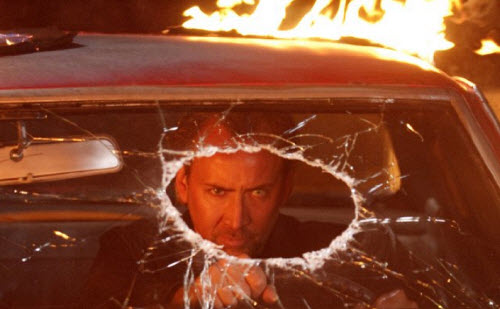
"A vengeful father escapes from hell and chases after the men who killed his daughter and kidnapped his granddaughter." This antiseptic description from IMDb fails to capture the hellacious power of 2011's first truly awesome grindhouse action flick.
Drive Angry 3D inhabits a fantastic world where Hell is envisioned as a literal prison for the souls of the damned who are forced to witness the suffering of their loved ones. Nicolas Cage plays John Milton, a character not unlike Todd McFarlane's Spawn, who steals "The Godkiller" and leaves Hell to hunt down Satanic cult leader Jonah King (Billy Burke) and save his grandchild. Along the way, he picks up Piper (Amber Heard), his partner in ass-kicking, while being pursued by The Accountant (William Fichtner). David Morse later turns up as Milton's best friend, Webster (Daniel perhaps?).
Review: I Am Number Four
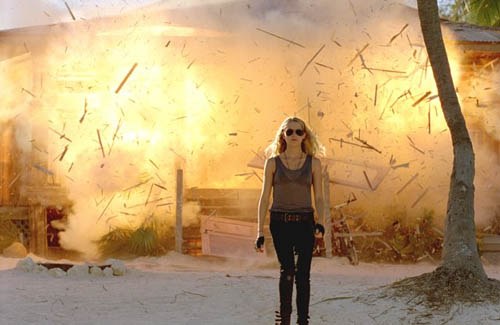
If I Am Number Four feels something like a Smallville episode, it should come as no surprise to learn the screenplay was penned by Smallville creators Alfred Gough and Miles Millar. This is compounded by the small-town high school setting, the orphaned-alien-with-superpowers plotline, and a lead actor -- Alex Pettyfer -- who bears an uncanny resemblance to Smallville's Justin Hartley (The Green Arrow). In fact, it plays like an extended pilot for a TV show that would develop a gigantic following on Fox only to be cancelled before the end of the first season. It's directed by D.J. Caruso, who also brought us Disturbia (the teen Rear Window) and Eagle Eye.
Evaluated by its big-screen merits, I Am Number Four still holds up as a strong film, which draws on familiar elements. The movie begins with an exciting bit of what I can only describe as "jungle parkour," which I could have watched for an hour alone. Another short scene at a beach party follows before the action moves to small-town Paradise, Ohio. John Smith (Pettyfer) has been dragged there, on one of many relocations, by his guardian and father-figure Henri (Timothy Olyphant). Rebelling against Henri's strict make-no-waves policy, he enrolls in the local high school where he picks up a new girlfriend (Glee's Dianna Agron) and picks a fight with her ex. From there, we're in standard teen romance territory until the bad guys eventually catch up to them.
Review: Sanctum
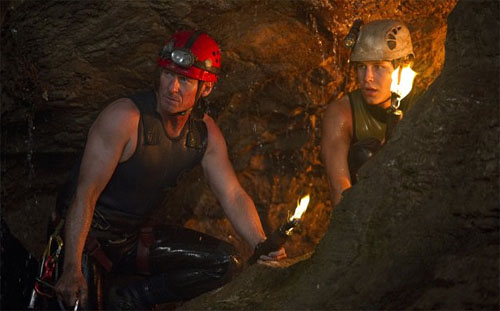
If all you've seen of Sanctum is in the TV spots, you probably think as I did that it was directed by James Cameron. His name is all over it, along with "3D Experience," "Titanic" and "Avatar." That's not surprising, given the virtually unknown director (Alister Grierson) and cast. The most recognizable faces here are Richard Roxburgh, best known as the Duke in Moulin Rouge, and Ioan Gruffudd, who has a steady following for his role as Horatio Hornblower and for playing Reed Richards in the Fantastic Four movies. If you watch the trailer (and I strongly recommend against that, as it spoils some of the most striking moments in the film), the words "executive producer" do appear above Cameron's name, but it feels almost like rewatching Avatar.
I expected Sanctum to be a grand 3D adventure shot with the same fantastic technology as Avatar. Instead, the moviequickly began to feel more like a combination of Alive and Jurassic Park (even using the phrase "spared no expense"). The 3D work at the beginning of the film was difficult to watch, forcing me at times to close one eye or another due to rapid close-up movement and shifts in perspective. Once everything had moved underground to more confined spaces, it became bearable and allowed me to focus on the action.

